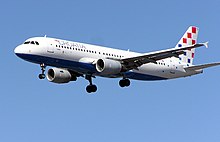Croatia Airlines: Difference between revisions
logo |
No edit summary |
||
| Line 61: | Line 61: | ||
*[[Italy]] |
*[[Italy]] |
||
**[[Rome]] ([[Leonardo da Vinci International Airport]]) |
**[[Rome]] ([[Leonardo da Vinci International Airport]]) |
||
*[[ |
*[[Republic_of_Macedonia|Macedonia]] |
||
**[[Skopje]] ([[Skopje Airport]]) |
**[[Skopje]] ([[Skopje Airport]]) |
||
*[[Netherlands]] |
*[[Netherlands]] |
||
Revision as of 22:29, 29 April 2007
| File:CroatiaAirlinesLogo.jpg | |||||||
| |||||||
| Founded | 1989 (as Zagal-Zagreb Airlines) | ||||||
|---|---|---|---|---|---|---|---|
| Hubs | Zagreb Airport | ||||||
| Focus cities | Dubrovnik Airport Split Airport | ||||||
| Frequent-flyer program | Miles & More | ||||||
| Alliance | Star Alliance | ||||||
| Fleet size | 11 | ||||||
| Destinations | 22 | ||||||
| Parent company | Croatia Airlines d.d. | ||||||
| Headquarters | Zagreb, Croatia | ||||||
| Key people | Ivan Mišetić (President and CEO) | ||||||
| Website | http://www.croatiaairlines.hr | ||||||


Croatia Airlines is the flag carrier airline based in Zagreb. It is the national airline of Croatia and a regional member of the Star Alliance. It operates services to domestic and international destinations. Its main base is Zagreb Airport (ZAG).
History
The airline was established on 20 July 1989 as Zagal - Zagreb Airlines, and started operations using Cessna 402 aircraft on cargo services for the UPS. The company used the name Zagal for short. After the first democratic elections held in Croatia, Zagal changed its name on July 23 1990 to Croatia Airlines.
In 1991 the airline signed an agreement with Adria Airways and then was able to lease a McDonnell Douglas MD-82 to start domestic jet services between Zagreb and Split. 1992 was a tough year for the company when the Yugoslav wars forced the airline to stop flying. As soon as flights restarted, Croatia Airlines bought three Boeing 737s from Lufthansa and became a member of the International Air Transport Association (IATA). That year also saw the airline's first international route.
In 1993 two ATR 42s and two more 737s joined the fleet, offices were opened in several European cities and the company bought a travel agency, Obzor, to organize travel for groups and individuals. By 1994, Croatia Airlines had welcomed its one millionth passenger. Later that year, Pope John Paul II flew the airline on a trip to Croatia.
In 1995, another ATR 42 was welcomed, as was the two millionth passenger. In 1996, Croatia Airlines became the first airline to fly to Sarajevo. In 1997 the airline's first Airbus A320 arrived and was nicknamed Rijeka. In 1998, another first plane of a new type arrived when the airline's first Airbus A319 joined the fleet. This airplane was nicknamed Zadar. Also that year, Croatia Airlines became a member of the Association of European Airlines (AEA). By 1999, two more Airbus jets had arrived and Croatia Airlines started selling the Boeing part of their fleet. Another important event occurred when the airline flew its five millionth passenger.
In 2000 two more Airbus planes arrived and an Automated Ticketing System was inaugurated. 2001 saw Croatia Airlines get maintenance and technical performing certificates from the German aviation authority Luftfahrt-Bundesamt. On November 18, 2004, Croatia Airlines joined the Star Alliance as a regional member, sponsored by Lufthansa.
Destinations
Croatia Airlines serves the following destinations (as of January 2006):
- Austria
- Belgium
- Bosnia and Herzegovina
- Croatia
- France
- Germany
- Italy
- Macedonia
- Netherlands
- Switzerland
- United Kingdom
Fleet
The Croatia Airlines fleet consists of the following aircraft (at August 2006) [1] :
| Aircraft | Total | Passengers (Business/Economy) |
Routes | Notes |
|---|---|---|---|---|
| ATR42-300 | 3 | 48(0/48) | Short haul routes | |
| Airbus A319-100 | 4 | 132 (12/120) | Short haul routes | |
| Airbus A320-200 | 4 | 164 (18/146) | Short and Medium haul routes | |
| Total Number of Aircraft | 11 |
References
- ^ Flight International, 3-9 October 2006
External links

